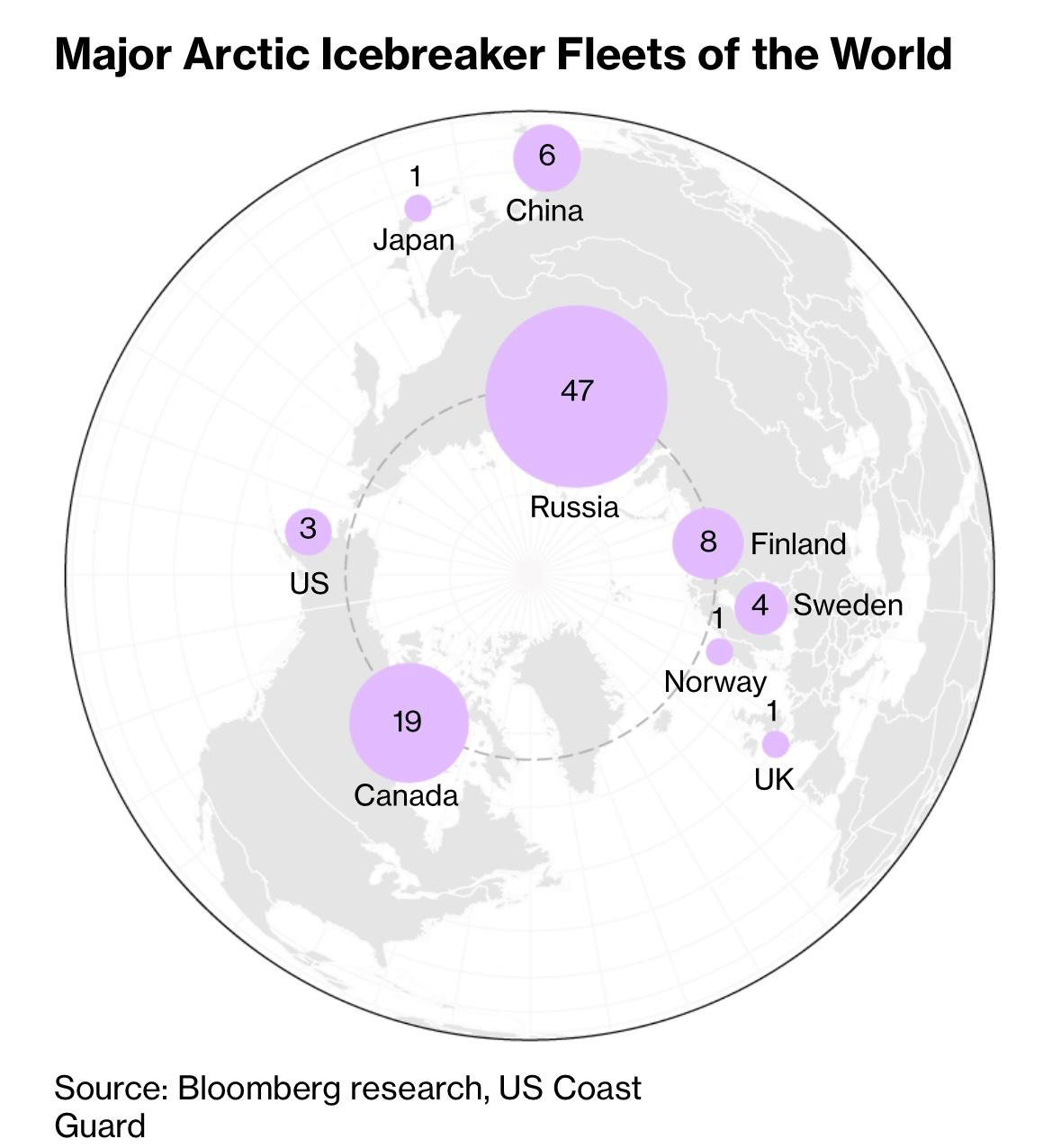Canada’s Arctic Blind Spot
Toronto Hackathon Tackles Arctic Surveillance Fix
🎯 Three-Shot Burst
On Saturday, we hosted Canada’s first defence tech hackathon, in partnership with NordSpace, SkyWatch, the DMZ, and Build Canada. NordSpace generously provided $10k in prize money to the top three teams. The Globe & Mail has the full story:
For the all-day hackathon, software and defence enthusiasts from across the country gathered to compete and rapidly develop scalable solutions for maritime surveillance in Canada’s North.
The event challenged participants to leverage satellite data and their range of expertise to find a better way to monitor vessel traffic in Canada’s Arctic waters.
Reality check: Monitoring of maritime traffic near Canada’s northern border is limited at best. According to a 2022 Auditor-General’s report, Canada has been for some time, largely unaware of the activity taking place in its Arctic waters, some of which it holds exclusive rights to explore and utilize through means such as fishing or mining.
Existing satellite systems positioned above the area capture single snapshots at a time, offering a fragmented view of the vast ocean often with a significant delay in transmission. Many of these satellites are also nearing the ends of their lives and don’t meet the needs of federal agencies and departments such as the Coast Guard or National Defence, the Auditor-General’s report said.
Oh Canada: This, compounded with the fact that much of Canada’s northern equipment and fleets are aging out, means the swath of water extending just beyond the country’s extensive coastline is largely shrouded in mystery. In fact, Transport Canada further scaled back its summertime surveillance of the Arctic this year.
Karim Bardeesy, parliamentary secretary to the Minister of Industry and a hackathon special guest, said the event’s Arctic emphasis was something that coming federal government policies, such as the defence industrial strategy, would likely also focus on.
Bottom line: The Icebreaker wishes to thank all of the participants, volunteers (especially W.B.), our generous partners, and the ~100 guests who showed up on a Saturday night to watch the final judged pitches. We have a lot of work to do to build up a true defence tech ecosystem in Canada, and this was a positive start, but only the beginning. The Icebreaker joined The BetaKit Podcast this week to talk about what it takes to build a defence tech ecosystem in Canada:
Related:
Find event photos here (thanks to our pal V.T.)
Based on the details of MP Bardeesy’s recent motion at the Industry Committee, we can likely expect the new defence industrial strategy sometime around the Halifax International Security Forum in November
Despite its relatively small stature, Canada's domestic defence ecosystem has the potential to grow into something robust and impactful
To strengthen Canada, start in the North… A sobering new assessment of Canada’s Arctic maritime infrastructure… Nations Aiming for Arctic Power Can’t Get Enough Icebreakers:
Arctic war games simulate Russia aggression in Canada's North
Everybody wants the Arctic. This map shows why:
A new PitchBook research note examines capital cycles, geopolitics, and dual-use demand in defence tech:
Defence tech exit activity peaked at 74 in 2021 and rebounded to 71 in 2024 as geopolitical shocks and rising defence budgets reignited strategic demand. M&A accounts for roughly 72% of exits, while IPOs and SPACs remain rare, reserved for scaled dual-use firms like Palantir, Rocket Lab, and Voyager. Valuations have swung from $534 million in 2022 to just $62 million in 2023, before surging to about $1.8 billion in 2025.
ADVERTISEMENT
Dominion Dynamics is building Canada’s next generation of sovereign defence technology, with a focus on Arctic sovereignty.
🤝 Sovereign Capability
Is Ottawa sitting on a future AI hardware champion?
Canada could be sitting on the TSMC for the next generation of data centre connectivity, hardware executives say. But to achieve its potential, they believe the federal government needs to let it go.
The Canadian Photonics Fabrication Centre (CPFC) in Ottawa is one of only three independent fabrication facilities in the world that manufacture the compound semiconductors that underpin photonics systems.
Executives at the likes of Inpho, Jabil and RANOVUS Inc. are calling for the the National Research Council to spin out the plant so it can use private funding to increase capacity and develop new capabilities.
The National Research Council of Canada, which runs the CPFC, has acknowledged the industry push, commissioning a valuation and governance review for the facility. But the hardware executives say it needs to make a quick decision.
Related:
Guncotton, not cotton candy: Arming Canada’s forestry sector:
Canada’s approach to critical defence inputs has long been more cotton candy than guncotton—pleasant but quick to dissolve under pressure. Nitrocellulose, or guncotton, is the propellant base for 155 mm artillery shells—munitions Canada already produces with domestic expertise and is scaling up to supply to allies. Yet despite being one of the world’s largest wood-pulp producers, Canada makes no nitrocellulose, leaving our assembly lines exposed to foreign inputs that are increasingly in short supply.
From Peace Dividend to Defence Dividend: Dual-Use, Quantum and NATO Targets… Is Relying on Dual-use Technology a Trap?
Quebec “lifts the taboo” on public money for the defence industry: The government, the Caisse de dépôt et placement du Québec and banks can now finance the production of military equipment
EU to Start Talks With UK, Canada on €150 Billion Defence Fund… Data key to keeping UK’s battleships ready for action
Canada’s defence future can’t stop at the F-35
The Race Is on to Make Rare Earth Magnets Outside China:
Canadian company Neo Performance Materials opened a factory in Narva, Estonia, that in one fell swoop has nearly doubled the available capacity of Europe and the United States to make magnets. Neo has also installed much of the equipment needed to more than double its factory’s output over the next several years.
⚔️ Combat Readiness
Red tape delaying deployment of new tech for Air Force
Bureaucratic processes are slowing down the rollout of new technology products for the country’s air force, says the director of a unit responsible for addressing innovation gaps within the force.
The director, Lieutenant-Colonel Amanda Whalen, heads the Royal Canadian Air Force Digital Hub, which was founded in 2023. She said in an interview that her team can build new digital applications – such as for search and rescue, mission logistics and cargo – in just three to six weeks, but is spending six to twelve months navigating policies and processes that are not keeping pace with modern technology.
“The limitation needs to be how fast my team can build products for the air force, not how fast we can navigate processes and policy and fill out paperwork,” Lt.-Col. Whalen told attendees of a digital technology conference last week
Related:
Our pals at Communitech hosted a primer on ‘Breaking into Defence’, with actionable tactical takeaways on compliance and competing for government contracts
Canadian Army releases Inflection Point 2025, the first document of a major restructuring program… NATO deterrence mission in Latvia drains the Canadian Army's fleet of vehicles
Forewarned: Canadian Industry and our New Defence Footing
Frenemies: Canadian Army lining up US rocket deal despite Carney pledge to cut back on American equipment… Canada's many U.S. military deals will be a tough sell to boycott-minded Canadians… U.S. warns Canada of potential negative consequences if it dumps F-35 fighter jet (N.B. review was set to be finalized yesterday)… The Department of National Defence signed a $14 million contract with Palantir Technologies to use its software for data processing and analytics in 2020, but didn’t disclose it at the time... Canada’s Department of National Defence using U.S. cloud services for ‘mission critical’ applications… 6 in 10 Canadians say they can never trust Americans the same way again
Calgary Enters Weapons and Security Race With $4.2M Contract
Lockheed's Skunk Works unveils Vectis, a stealthy drone wingman
The Pentagon’s new startup focus is pushing established companies to try new strategies… Army launches VC-style model FUZE program to invest early in promising military tech… The Next Anduril: Why Defence Tech's Biggest Bet is About to Change
Cyber war: Heathrow warns of second day of disruption after cyber attack… Millions of Chinese-made internet-connected devices are potential ticking time bombs, including electric vehicles
Russian aggression: Why does Russia send drones into Poland and MiGs into Estonia? Because Cold War-era deterrence doesn’t work anymore… Europe’s new battle to defend its skies from Russia… The Turks dealt with this in 2015… The good guys have a few moves up our sleeve too: By closing its border with Belarus, Poland has played its Joker card, limiting the flow of Chinese goods to Europe:
By closing its border with Belarus, Poland is effectively cutting China off from a €25 billion-a-year trade route. Approximately 90% of China-EU rail freight passes through Poland, which is now suspended amid the Zapad-2025 drills and a Russian drone incursion. Beijing requested that Warsaw restore the route, but after three hours of talks, Warsaw refused. With sea routes slower and air transport up to 30% more expensive, Europe’s e-commerce supply chains face serious disruption.
🍁 Prepare for Liftoff
Our aforementioned pals at NordSpace are inside the launch window: NordSpace will be making history by performing the first commercial rocket launch in Canada — a fully privately funded and managed initiative crucial for Canada to build a space launch capability that supports our security, economy, and sovereignty. Good luck to CEO Rahul Goel and the crew!
Related:
Waterloo rocketry team reaches new heights with Canada’s first ever liquid rockets
Nation-Building Projects? How about Airships?
Canada seeking proposals for a Defence Innovation Secure Hub (DISH)
Inside the Space Force as it prepares for a new kind of war… A top secret US spacecraft takes flight – and it could rewrite the rules of future warfare
Small US defence stocks soar on rush for next-gen battlefield tech
🔫 Hot Shots
Under the sea: How a larger defence budget may unintentionally lead to Canada having a hollow force… Canada’s submarine choice could break tradition, embrace South Korea in Indo-Pacific shift… Ottawa's pick will hinge on economic windfall… As part of his visit to Germany, PM Mark Carney toured the Thyssenkrupp Marine Systems (TKMS) shipyard in Kiel… A Canadian defence blog interviews Hanwha executives about their bid… Military acquisitions come down to capability, cost, and economic benefits, but tone can matter, too:
Two buck chuck?: Drones have transformed the nature of war. But Israel claims to have deployed the world’s first effective and battle-tested laser interception system. Rafael Industries announced the official release of a system to take down rockets, UAVs and even mortars for $2 per interception. The cost per Iron Dome interception was about $60,000… Russia has been attacking Ukraine with a jet-powered variant of its Shahed drone since June… U.S. Needs To Be Building Tens Of Thousands Of Shahed-136 Clones Right Now — this is ‘reverse innovation’ in global defence… Somewhere around 90% of all Ukrainian drone components come from China alone… What is the real cost of an FPV drone?… Swarmer, leading Ukrainian drone swarm company, announces $15m Series A 🚀 led by US investors
Factory at the front: Divergent Technologies, a leading defence manufacturing startup, secured $290 million in funding led by Rochefort Asset Management… What was the last time democracy depended on ramping production of military hardware?
Whodunnit: The 80s era tale of tracking a hacker stealing classified military information and selling it to the KGB… CSIS warning shows Ottawa can’t keep ignoring Canada’s IP crisis
All aboard: Hedosophia recruits ex-NATO Innovation Fund partner, mulls new defence fund
Swaggy P: Defence tech’s hottest new weapon is company swag. On that note, The Icebreaker has vintage ‘47 brand clean up ball caps, and we’ll send you one if you can refer us an advertising partner!
If you’ve got battlefield intel, classified tips, or just want to call in an airstrike on our typos, hit “reply” and sound off. Whether it’s a new tech sighting, a rumour from the mess hall, or feedback on our comms, we want your SITREP.











Was cool hearing your founder speak about the terribly bad Canadian atitude of finding anything defence-related distasteful and ostracizing people involved in anything defence-facing.
Compared to the US where the dividends of a strong defense and military base is what has made the US the greatest country in the world and still one of the most prosperous ones, Canadians have been so insulated from what the real world order is controlled and maintained by, and are going to have to shift that mindset completely if Canada is going to still be what she was know as today, and hopes to be in the future.